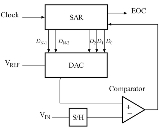
Successive Approximation ADC
Overview
Analog-to-digital converter
An analog-to-digital converter is a device that converts a continuous quantity to a discrete time digital representation. An ADC may also provide an isolated measurement...
that converts a continuous analog
Analog signal
An analog or analogue signal is any continuous signal for which the time varying feature of the signal is a representation of some other time varying quantity, i.e., analogous to another time varying signal. It differs from a digital signal in terms of small fluctuations in the signal which are...
waveform into a discrete digital
Digital
A digital system is a data technology that uses discrete values. By contrast, non-digital systems use a continuous range of values to represent information...
representation via a binary search through all possible quantization
Quantization (signal processing)
Quantization, in mathematics and digital signal processing, is the process of mapping a large set of input values to a smaller set – such as rounding values to some unit of precision. A device or algorithmic function that performs quantization is called a quantizer. The error introduced by...
levels before finally converging upon a digital output for each conversion.
Key
- DAC = Digital-to-Analog converter
- EOC = end of conversion
- SAR = successive approximation register
- S/H = sample and hold circuit
- Vin = input voltage
- Vref = reference voltage
The successive approximation Analog to digital converter circuit typically consists of four chief subcircuits:
-
- A sample and hold circuit to acquire the input voltageVoltageVoltage, otherwise known as electrical potential difference or electric tension is the difference in electric potential between two points — or the difference in electric potential energy per unit charge between two points...
(Vin). - An analog voltage comparator that compares Vin to the output of the internal DACDigital-to-analog converterIn electronics, a digital-to-analog converter is a device that converts a digital code to an analog signal . An analog-to-digital converter performs the reverse operation...
and outputs the result of the comparison to the successive approximation registerProcessor registerIn computer architecture, a processor register is a small amount of storage available as part of a CPU or other digital processor. Such registers are addressed by mechanisms other than main memory and can be accessed more quickly...
(SAR). - A successive approximation register subcircuit designed to supply an approximate digital code of Vin to the internal DAC.
- An internal reference DAC that supplies the comparatorComparatorIn electronics, a comparator is a device that compares two voltages or currents and switches its output to indicate which is larger. They are commonly used in devices such as Analog-to-digital converters .- Input voltage range :...
with an analog voltage equivalent of the digital code output of the SAR for comparison with Vin.
- A sample and hold circuit to acquire the input voltage
The successive approximation register is initialized so that the most significant bit
Most significant bit
In computing, the most significant bit is the bit position in a binary number having the greatest value...
(MSB) is equal to a digital
Digital
A digital system is a data technology that uses discrete values. By contrast, non-digital systems use a continuous range of values to represent information...
1.

